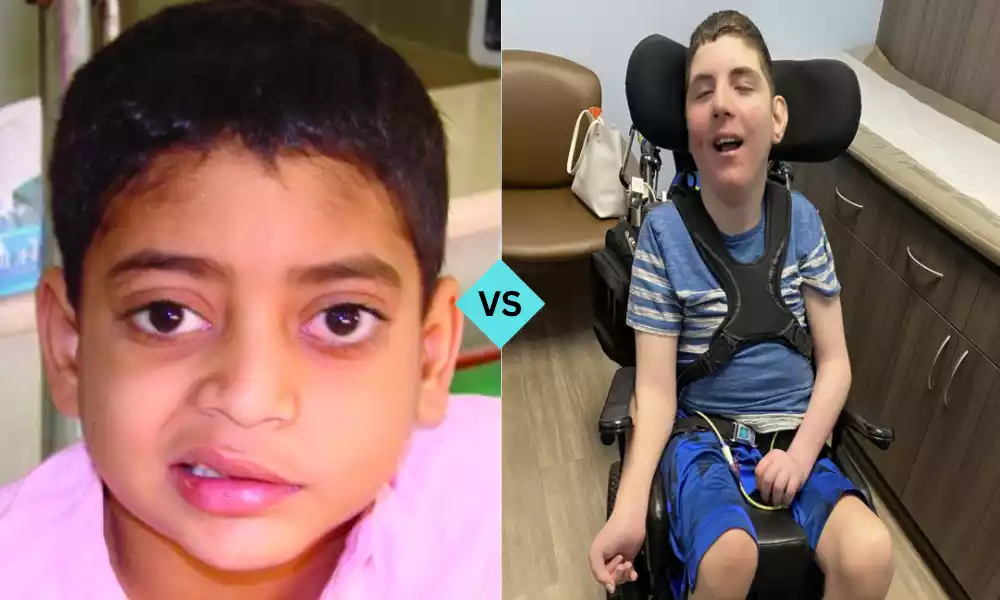Introduction
Bell’s Palsy and Cerebral Palsy are two distinct medical conditions, often confused due to their similar-sounding names. While both conditions affect individuals’ motor functions, they have vastly different causes, symptoms, and treatments. In this comprehensive article, we will delve into the depths of these two conditions to understand their definitions, causes, symptoms, and the crucial importance of distinguishing between them. We will also explore their differences and similarities, diagnosis methods, treatment approaches, the impact on global health, and preventive measures.
Definition of Bell’s Palsy
Bell’s Palsy is a sudden, temporary neurological condition that causes weakness or paralysis of the facial muscles, typically on one side of the face. This condition results from inflammation of the facial nerve (cranial nerve VII) and can lead to symptoms such as facial drooping, difficulty in closing the eye, changes in taste perception, and altered tear production. Bell’s Palsy often resolves on its own within weeks to months, and its exact cause remains unclear.

Causes Bell’s Palsy
The primary causes and contributing factors of Bell’s Palsy include:
- Viral Infections: Such as herpes simplex virus (HSV), varicella-zoster virus, Epstein-Barr virus, and respiratory infections.
- Immune System Response: An abnormal immune system reaction, where the immune system mistakenly attacks the facial nerve.
- Genetics: Family history may slightly increase the risk.
- Facial Nerve Inflammation: Inflammation of the facial nerve, which can result from various factors and lead to muscle weakness or paralysis.
Definition of Cerebral Palsy
Cerebral Palsy is a group of lifelong neurological disorders that affect muscle control, movement, and posture. It typically originates in early childhood and is caused by abnormal brain development or damage to the developing brain, often occurring before, during, or shortly after birth. Cerebral Palsy can manifest in various forms, leading to a wide range of physical and developmental challenges, including difficulties with mobility, muscle coordination, speech, and daily activities.

Causes of Cerebral Palsy
The causes of Cerebral Palsy can be diverse and may include:
- Prenatal Factors: These factors occur before birth and can include maternal infections, exposure to toxins, genetic mutations, and certain medical conditions during pregnancy.
- Perinatal Factors: Events during labor and delivery can contribute to Cerebral Palsy, such as oxygen deprivation, trauma, or other complications during the birthing process.
- Postnatal Factors: Head injuries and infections in early infancy can also lead to Cerebral Palsy, although they are less common causes.
- Unknown Causes: In some cases, the specific cause of Cerebral Palsy may not be readily identifiable. It may result from a combination of factors or unknown factors during development.
These factors can vary from one individual to another, making Cerebral Palsy a complex condition with a range of potential causes.
Symptoms of Bell’s Palsy and Cerebral Palsy
- Bell’s Palsy:
-
- Facial Weakness: Sudden weakness or paralysis of the facial muscles, typically on one side.
- Drooping of the Face: One side of the face may droop, making it difficult to smile or close the eye.
- Loss of Taste and Changes in Tear Production: Altered taste and decreased tear production on the affected side.
- Increased Sensitivity to Sound in One Ear: Heightened sensitivity to sound in one ear (hyperacusis).
- Difficulty Closing the Eye and Drooping Eyelid: Inability to fully close the eye and a drooping eyelid.
- Increased Salivation and Loss of the Ability to Taste on the Front Two-Thirds of the Tongue: These symptoms are due to the involvement of the facial nerve in taste and salivary function.
- Cerebral Palsy:
-
- Motor Impairments: Difficulties with muscle coordination, control, and balance.
- Spasticity or Stiffness: Muscles may become stiff, making movement challenging.
- Involuntary Movements: Involuntary muscle contractions and spasms.
- Gait Disturbances: Abnormal walking patterns, such as toe-walking or scissoring gait.
- Speech and Communication Difficulties: Impaired speech and communication skills.
- Seizures: Some individuals with cerebral palsy may experience seizures.
Importance of Distinguishing Between Bell’s Palsy and Cerebral Palsy
Distinguishing between Bell’s Palsy and Cerebral Palsy is of paramount importance due to the following reasons:
- Different Underlying Causes: Bell’s Palsy is primarily related to facial nerve inflammation, while Cerebral Palsy is rooted in brain damage or abnormal development. Accurate diagnosis is essential to determine the appropriate treatment approach.
- Age of Onset: Bell’s Palsy typically occurs in adulthood, while Cerebral Palsy is a condition present from early childhood. This distinction aids in narrowing down potential diagnoses.
- Treatment Implications: Effective treatment strategies for Bell’s Palsy may not be suitable for individuals with Cerebral Palsy. Misdiagnosis could lead to inappropriate therapies and delayed interventions.
- Prognosis: The prognosis for these conditions varies significantly. Bell’s Palsy often resolves on its own, while Cerebral Palsy is a lifelong condition that requires long-term care and support.
- Emotional and Psychological Impact: Misdiagnosis can have a profound emotional and psychological impact on patients and their families. Accurate diagnosis provides clarity and helps individuals access appropriate support.
Comparison Table of Bell’s Palsy and Cerebral Palsy
Here’s a comparison table summarizing the key differences between Bell’s Palsy and Cerebral Palsy:
| Aspect | Bell’s Palsy | Cerebral Palsy |
|---|---|---|
| Age of Onset | Typically in adulthood (around 40 years) | Early childhood |
| Primary Symptoms | Facial weakness or paralysis | Motor coordination difficulties |
| Duration of Symptoms | Weeks to months, often resolves | Lifelong |
| Underlying Causes | Viral infections, genetics, immune factors | Brain damage or abnormal brain development |
| Treatment | Medications, physical therapy | Multidisciplinary approach, therapy, surgery |
| Prognosis | Generally good, recovery expected | Lifelong condition, outcomes vary |
| Impact on Daily Life | Temporary difficulties in daily activities | Significant impact on mobility and function |
This table provides a concise overview of the primary differences between Bell’s Palsy and Cerebral Palsy, covering age of onset, symptoms, duration, causes, treatment, prognosis, and impact on daily life.
Similarities Bell’s Palsy and Cerebral Palsy
While Bell’s Palsy and Cerebral Palsy are fundamentally different conditions, there are a few similarities:
- Neurological Involvement: Both conditions involve the nervous system. Bell’s Palsy affects the facial nerve, while Cerebral Palsy results from brain abnormalities.
- Motor Impairments: Both conditions can cause motor impairments. Bell’s Palsy leads to facial muscle weakness, while Cerebral Palsy affects muscle coordination and control.
- Impact on Quality of Life: Both conditions can impact an individual’s quality of life, although the extent and nature of the impact differ significantly.
- Multidisciplinary Care: Treatment and management for both conditions often require a multidisciplinary approach, involving healthcare professionals from various specialties.
Diagnosis of Bell’s Palsy and Cerebral Palsy
- Bell’s Palsy:
-
- Diagnosis of Bell’s Palsy is typically clinical, based on a physical examination and medical history.
- Healthcare providers may use additional tests such as electromyography (EMG) and imaging (MRI or CT scan) to rule out other potential causes of facial weakness.
- Cerebral Palsy:
-
- Diagnosis of Cerebral Palsy usually occurs in early childhood, often by a pediatrician or pediatric neurologist.
- It involves a comprehensive assessment of a child’s motor skills, developmental milestones, and medical history.
- Brain imaging studies, such as MRI, may be used to identify brain abnormalities.
Treatment Approaches for Bell’s Palsy and Cerebral Palsy
- Bell’s Palsy:
-
- Medications: Corticosteroids like prednisone are often prescribed to reduce inflammation.
- Eye Protection: Eye drops and ointments may be recommended to prevent corneal damage due to reduced tear production.
- Physical Therapy: Exercises can help maintain muscle tone and improve facial muscle strength.
- Supportive Care: Patients may need to tape their eye shut at night and protect it during the day.
- Cerebral Palsy:
-
- Physical Therapy: Focuses on improving mobility, muscle strength, and functional independence.
- Occupational Therapy: Aims to enhance daily living skills and fine motor control.
- Speech Therapy: Helps with speech and communication difficulties.
- Assistive Devices: Mobility aids, braces, and communication devices may be necessary.
- Medications: Medications can help manage spasticity and seizures in some cases.
- Surgery: Orthopedic surgeries may be performed to improve joint function.
Impact on daily life of Bell’s Palsy and Cerebral Palsy
Impact on Daily Life of Bell’s Palsy:
- Short-term facial weakness, drooping, and difficulty in closing the eye affect facial appearance and expressions.
- Eating and drinking may be challenging due to difficulty in controlling mouth movements.
- Eye care is necessary to prevent dryness and potential corneal damage.
- Speech and communication may be temporarily affected.
- Emotional distress and social interactions can be impacted during the acute phase.
- Eye protection and adjustments to daily routines may be required.
Impact on Daily Life of Cerebral Palsy:
- Profound and long-lasting mobility challenges may necessitate assistive devices.
- Basic tasks like dressing and feeding may require assistance.
- Speech and communication difficulties vary and may require specialized tools.
- Education often involves tailored services to address learning needs.
- Social interactions and relationships can be influenced by movement and communication difficulties.
- Employment opportunities may be limited for some individuals.
- Ongoing medical care, therapies, and daily assistance are often needed.
- Quality of life varies widely depending on the severity of the condition, level of support, and access to healthcare and rehabilitation services.
How to Prevention of Bell’s Palsy and Cerebral Palsy
Preventing Bell’s Palsy and Cerebral Palsy involves different strategies:
Preventing Bell’s Palsy:
- Viral Infection Management: Practice good hygiene to reduce the risk of viral infections, as they may contribute to Bell’s Palsy. Avoid close contact with people who have active herpes infections.
- Healthy Lifestyle: Maintain a healthy lifestyle with a balanced diet, regular exercise, adequate rest, and stress management to support overall immune system health.
- Immunization: Consider immunization against specific viruses, like influenza and varicella-zoster (chickenpox and shingles).
Preventing Cerebral Palsy:
- Prenatal Care: Attend all prenatal check-ups, manage chronic conditions, and follow healthcare provider recommendations for a healthy pregnancy.
- Infection Control: Practice good hygiene and receive recommended vaccinations during pregnancy to reduce the risk of infections that could affect the developing fetus.
- Nutrition: Consume a well-balanced diet with prenatal vitamins and folic acid to support fetal development.
- Avoid Toxins: Avoid smoking, alcohol, drugs, and environmental toxins during pregnancy.
- Monitoring Fetal Health: Regularly monitor the fetus’s health through prenatal tests and ultrasounds.
- Safe Delivery: Choose a healthcare facility with experienced obstetric care for a safe childbirth.
- Postnatal Care: Ensure timely well-baby check-ups and early intervention services if developmental delays are detected in infants.
Prevention of Bell’s Palsy involves managing viral infections and maintaining a healthy lifestyle, while preventing Cerebral Palsy requires comprehensive prenatal care, infection control, and safe childbirth practices.
Conclusion
Bell’s Palsy and Cerebral Palsy are distinct neurological conditions with varying causes and lifelong impacts. Bell’s Palsy, typically occurring in adulthood, often results from viral infections and presents temporary facial muscle weakness. In contrast, Cerebral Palsy, originating in early childhood due to brain damage, leads to enduring motor coordination challenges.
Prevention involves managing viral infections for Bell’s Palsy and comprehensive prenatal care and safe childbirth practices for Cerebral Palsy. Understanding these differences is crucial for timely diagnosis and appropriate treatment.































